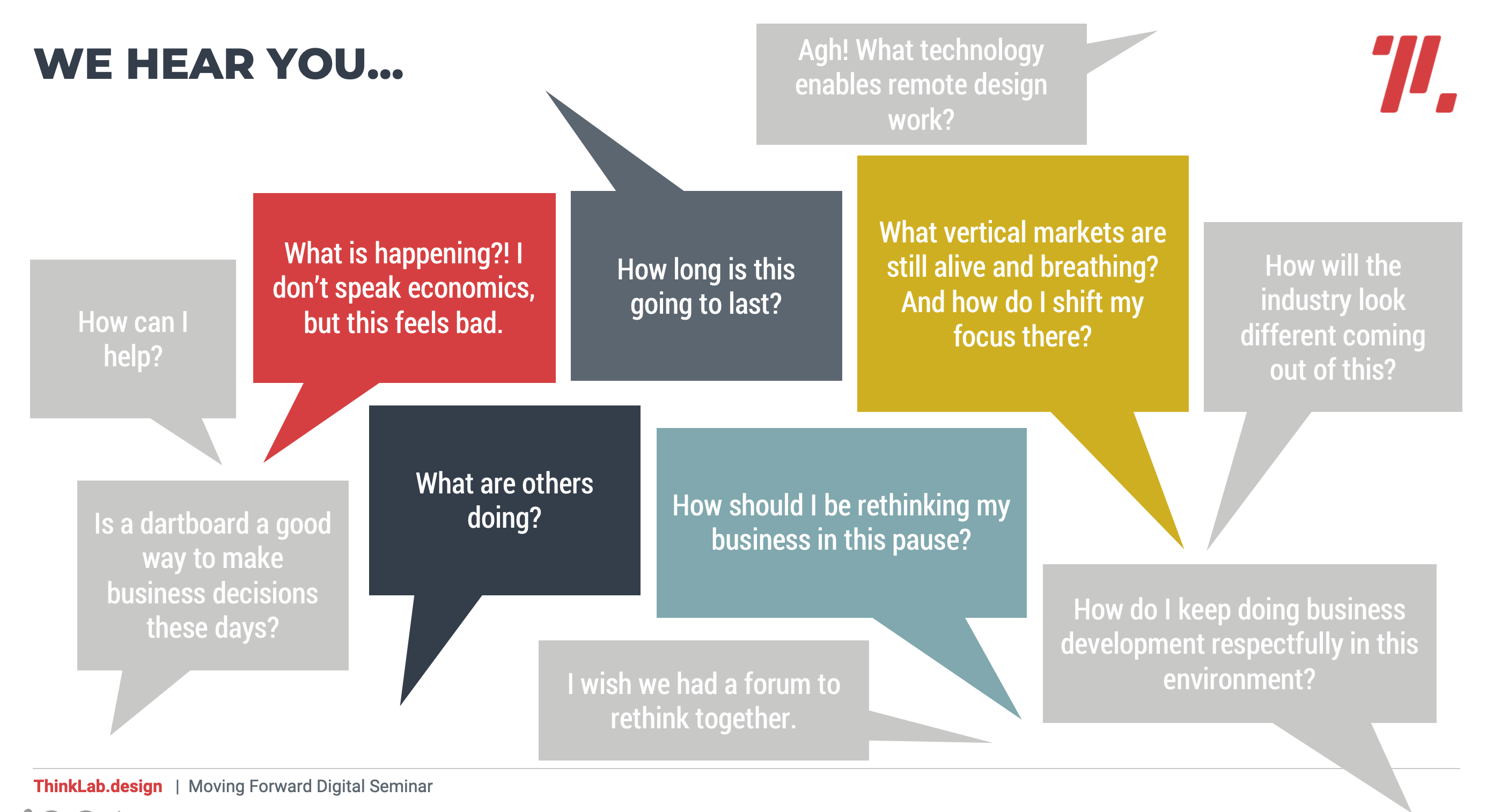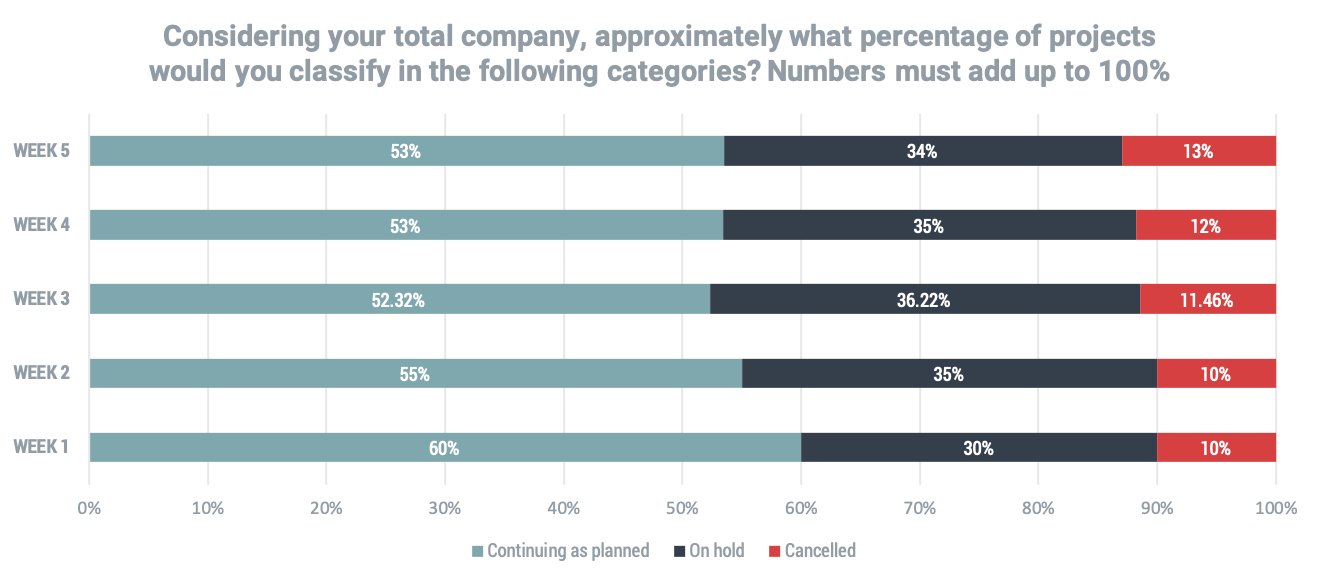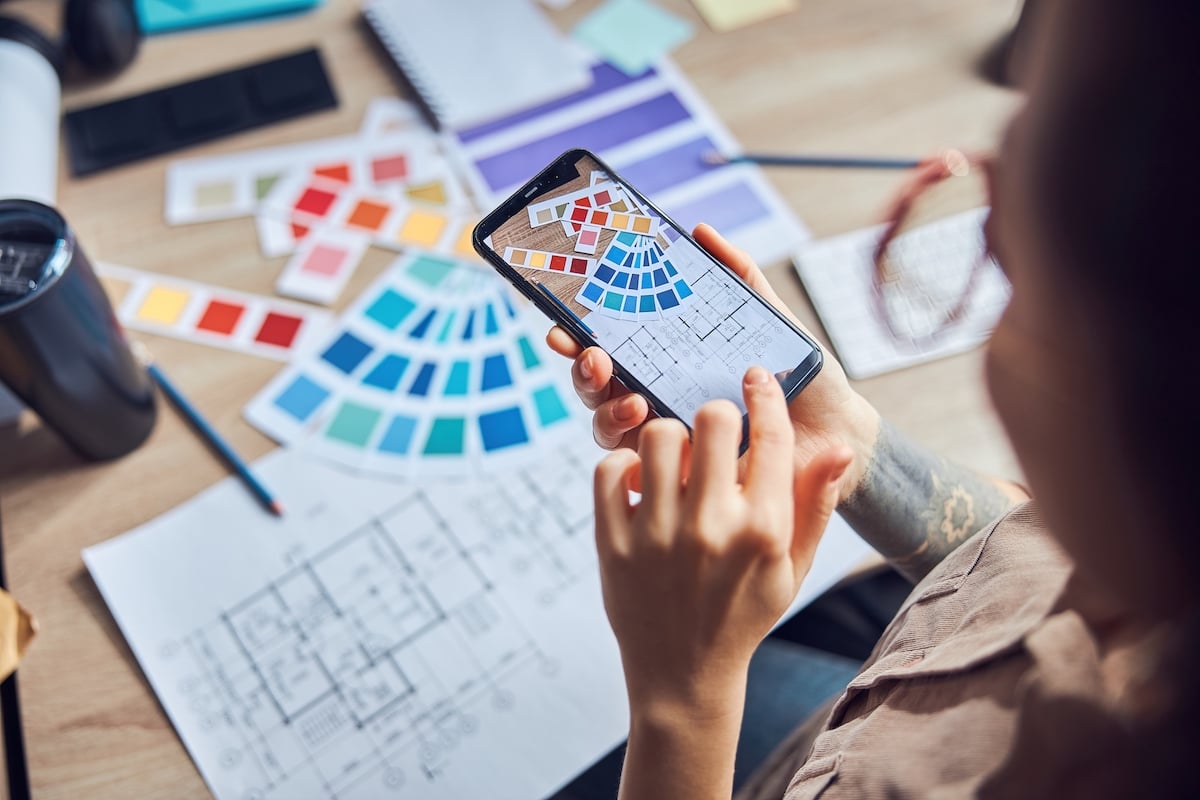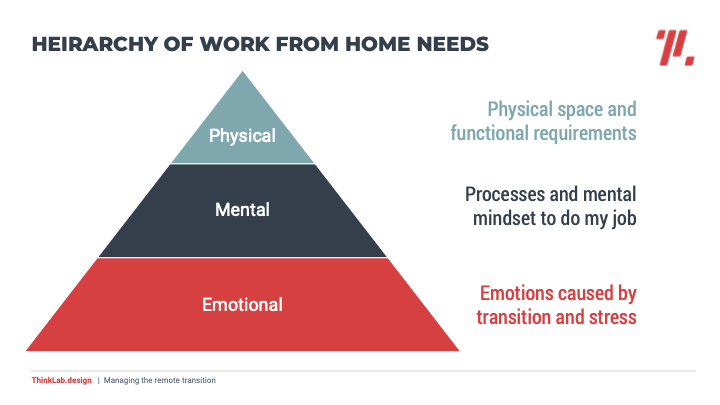
At ThinkLab, we believe perspective narrows out fear, and that the quality of decisions you make is directly related to the data you have. For that reason, we have been leveraging our reach as part of the SANDOW family of brands to crowd source data on the impact of COVID-19 on the design industry since mid-March. In this article, we will share a high-level summary, but for more perspective, we invite you to watch a recording of our April 24 digital seminar titled Moving Forward: Preparing Your Business for the Un-Pause. In this session, we leveraged a mix of primary and secondary techniques to answer many of the industry’s most burning questions in this time of crisis. We’ll share a few of the responses here. (Don’t worry, we are still working on answering more.)
What are others doing?
At ThinkLab, our passion exists at the intersection of specification and design, where we use research to improve communication between designers and manufacturers. As the global economy feels the effects of Covid-19, we believe in the power of sharing best practices in order to collectively move forward. As of WEEK 5 of our measure, we have more than 1,200 datapoints voluntarily submitted by various members of the A&D, manufacturing and distribution communities to help you understand how others are navigating their business’s response to the pandemic. Note that the survey was launched March 27 and the survey is closed every Thursday. Here are a few highlights of what we’ve seen:
- EMPLOYMENT HEALTH: We’ve steadily seen “layoffs” rise, reaching 8.76 percent as of WEEK 5 of our data collection. However, in WEEK 3 (April 10-April 16) we saw the percent of those “taking action” in some way (including layoffs, furloughs, pay cuts and other similar combinations) cross the 50 percent mark. Many firms, manufacturers, and distributors alike are predominantly focused on temporary measures such as furloughs or pay cuts in order to retain the staff they have worked so hard to recruit and train in a time of very low unemployment.
 Metrics on employment restructuring. Image credit: ThinkLab
Metrics on employment restructuring. Image credit: ThinkLab - PROJECT HEALTH: WEEK 1 of our measure suggested that 60 percent of projects were continuing as planned, while 30 percent immediately went on hold and 10 percent were immediately cancelled. Each week we see the numbers slightly shift from continuing, to on hold; and from on hold, to cancelled; however, at the time of writing this article it appears that the initial shock to the system may have passed and things are steadying out with the number “continuing as planned” in WEEK 5 still at a steady 53 percent (equal to WEEK 4). Many projects that were in the later phase of design appear to be continuing where construction is possible, while many of the “cancelled” and “on hold” projects appear to be those in the earlier phases, though there are also many exceptions. On the bright side, we have added a way to measure “new project kickoffs” and there are new projects kicking off (though few). And, obviously there are a few areas (like critical healthcare facilities) that are accelerating.
 Metrics on project status. Image credit: ThinkLab
Metrics on project status. Image credit: ThinkLab - BID ACTIVITY: Our research suggests that for a steady 20 percent, bid activity is continuing as usual, while the majority say that bid activity is slow or stopped. After a steady decline from WEEK 2-WEEK 4 in percentage of bid activity “stopped or nearly stopped” (moving from 17 percent down to 13 percent, respectively) WEEK 5 responses suggest our highest weekly measure (18.5 percent) of bid activity as “stopped or nearly stopped.” And, for the first time, WEEK 5 saw not a single respondent (out of more than 300 respondents) report that bid activity is well above average. (Previous weeks had run between 3-5 percent of respondents suggesting some bid activity is above average.)
-
We invite you to take part in this survey, but you must give to get. Results of the survey were sent week by week in the first four weeks, and will be sent every two weeks moving forward. If you take the survey by April 6, you will be included on our next send. There are also opportunities to submit questions for ThinkLab to explore within the industry.
How long will this last?
Perhaps the most burning question on everyone’s mind is, “When will this be over?” It’s like running a marathon, but we don’t know where the finish line is. For that reason, pace yourself. Here are some facts about our current economic state translated for the design industry. (Think of this as economics 101 for the right brained):- In a nutshell, the impact of the pandemic has been swift and harsh. Q2 2020 has seen one of the sharpest drops in U.S. GDP ever measured and could be (we hope) the single fastest drop in our lifetime. Per Oxford Economics, the cruel “lockdown paradox” is that the more severe the containment measures are, the faster we’ll get past the virus, but the sharper the economic hit will be.
- Roughly 26 million Americans have filed for unemployment in just a few weeks. Comparing to unemployment in the 2008 recession, (also per Oxford Economics) 8.6 million filed for unemployment over two years.
- Best case scenario for recovery is a “V” recovery (think sharp decline, quick bounce back), however it’s important for the design industry to remember that our category lags, and especially in this case with phased “back to work” scenarios. Per a recent CBRE flash call, even if the economy recovers quickly, the design industry’s recovery is more likely to look like a “Nike swoosh.”
For more detailed information on this and where different sectors of the design industry fit into the economics projections, we invite you to watch our full webinar on the topic here.
What vertical markets are still alive and breathing? And how do I shift my focus there?
The webinar mentioned above shares a sneak peek of ThinkLab’s forthcoming Hot Market Growth Report that will outline areas of likely geographic and vertical market growth comparing pre-COVID stats to post-COVID predictions. However, we caution that that this, too, shall pass. So, we encourage everyone to be thoughtful in your response and stay focused. As Joey Ruiter, a talented product designer put it, “I’ve been flat out saying ‘no’ when I’m asked to implement bad idea Band-Aids. It feels like we are forgetting what good spaces feel like.”
In contrast, many of you have begun to reimagine how spaces can aid in easing fear as we return to the office. This HBR article reminds us that with imagination, we can do better than merely adapting to a new environment — we can thrive by shaping it. And we applaud those who are doing just that.
What can I be doing to rethink my business in this pause?
While we do not wish this health or economic situation on anyone, there are silver linings in every storm. We invite you to join us in this great pause to proactively reIMAGINE how we want to shape our lives, our spaces, our careers, and our industry moving forward. ThinkLab will be hosting a series of virtual generative research sessions (think design thinking for the design industry) to help us do just that. And, for our manufacturer partners, we invite you to learn more about our Moving Forward Workshop that helps apply 10 bold predictions to your business as we prepare to emerge. We thank you for trusting ThinkLab.Featured image: ThinkLab compiles some of the commonly heard sentiments regarding COVID-19. Image credit: ThinkLab
This article originally was published in Bellow Press and was reposted here with permissions.
Amanda Schneider is President of ThinkLab, the research division of Interior Design Media. At ThinkLab, we combine Interior Design Media’s incredible reach within the architecture and design community with proven market research techniques to uncover relevant trends and opportunities that connect back to brand and business goals in a thought-provoking, creative, and actionable way. Join in to know what’s next at thinklab.design/join-in.


